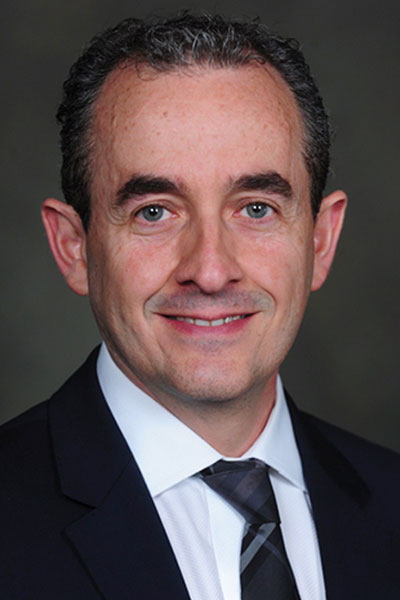To help match patients with survival-boosting targeted treatments and immunotherapies, it’s important to test lung cancers for a growing number of biomarkers.
But to make that happen, doctors must be familiar with biopsy best practices. In the CHEST 2022 session, Diagnostic Lung Cancer Evaluation: Tissue Sampling, Imaging & Blood Based Molecular Profiling, on Monday, October 17, panelists discussed minimally invasive tissue- and blood-based biopsies for use in next-generation sequencing (NGS) and lung cancer staging.
These techniques are crucial because of the speed at which driver mutations are becoming actionable, a trend that continues to splinter lung cancer into subsets, said Raymond U. Osarogiagbon, MBBS, chief scientist at Baptist Memorial Health Care Corporation and director of the multidisciplinary thoracic oncology program at Baptist Cancer Center in Memphis. According to Dr. Osarogiagbon, since 2012, the proportion of undruggable mutations found in lung adenocarcinomas has shrunk from nearly one-half to about 11%.
“Yet, biomarker testing is still not everywhere, and the majority of people who are candidates for it don’t get it,” he said. “Disparities and horrible geographic heterogeneity are already emerging.”

Considering tissue-based biopsies
Although tissue biopsies can be obtained through open surgery or by inserting a needle, endoscope, or mediastinoscope through the chest wall, endobronchial ultrasound (EBUS) or endoscopic ultrasound using a flexible bronchoscope (EUSB) are less invasive options for the biopsy of central lesions in the lung parenchyma, mediastinum, airway, or esophagus. Learn more about enhancing your expertise with EBUS and transbronchial needle aspiration.
Samples harvested this way are small, so doctors must use clinical information to identify conditions such as adenomatous hyperplasia or adenocarcinoma in situ. Still, the biopsies capture enough tissue to determine a cancer’s type and to run NGS assays, said Erik Folch, MD, MSc, assistant professor of medicine at Harvard Medical School and chief of the complex chest disease center and co-director of interventional pulmonology at Massachusetts General Hospital.
The most important factor in the usability of these samples is that the tissue is processed immediately and properly, whether as a core biopsy or a cell block.
Dr. Folch pointed to robotic bronchoscopy and cryobiopsy as promising biopsy techniques but said sputum samples don’t provide enough diagnostic certainty. He described EBUS/EUSB as a happy medium.
“We all want 100% certainty,” he said, “but that is obtained by surgery, which has the highest risk of complication.”

The role of blood-based biopsies
Despite becoming more widely available, liquid biopsies are still finding their place in practice.
Dr. Folch uses blood-based biopsies when lesions are difficult to access, other methods are too risky for a patient, or human or technological capital are lacking. But Dr. Osarogiagbon sees them in more of a complementary role.
He described liquid biopsies as a safe, patient-friendly alternative to tissue-based techniques, which are more invasive, garner tissue of variable quality, can be inaccurate due to tumor heterogeneity, may induce patient anxiety, and take weeks to return results. He added that liquid biopsies may be less susceptible to heterogeneity, and thus more prognostic, because they find the cells that escape from tumors, “markers of the worst of the worst.”
“If blood-based tests become less expensive and more regularly available, maybe we can do them concurrently with other things,” Dr. Osarogiagbon said. “Already, a lot of us are doing blood-based tests first. If we get an answer, we run with it, and if not, we get tissue.”

Staging is crucial
But diagnosis and treatment planning should not be based on NGS results alone. Staging cases of non-small cell lung cancer is also crucial, said Catherine L. Oberg, MD, associate program director of interventional pulmonology and assistant professor of clinical medicine at the David Geffen School of Medicine at UCLA. Nevertheless, in a study of nearly 3,000 patients with lung cancer who underwent potentially curative resection at 11 hospitals between 2009 and 2018, only 22% of cancers were staged.
Fortunately, practitioners relying on EBUS/EUSB to harvest biopsies for NGS are moving in the right direction, as those tests are also good first choices for use in staging, Dr. Oberg said.
Conducted in the mediastinum and hilum, staging should be offered to most patients being assessed for lung cancer because previously undetected lymph node metastases may be discovered, she said. Staging may be skipped when lesions are 2 cm to 3 cm and located in the outer third of the lung or if disease has aggressively invaded the liver or pleural space.
“We have to stage anyone with a tumor greater than 3 cm, and you can make an argument for 2 cm or 1 cm if the lesion is solid,” Dr. Oberg said. “Anyone who has nodal disease on CT or PET CT, a small central lesion, or distant disease should undergo staging, even when the mediastinum and hilar are radiographically negative.”
While thoracic specialists at teaching hospitals are most likely to conduct staging, the practice is beginning to spread, as is the likelihood of its compliance with guidelines. Still, Dr. Oberg said, “we have work to do in this area.”
This panel was planned in collaboration with CHEST’s Thoracic Oncology and Chest Procedures Network and its Interventional Procedures Section. It was supported by an educational grant from Merck Sharp & Dohme, LLC; Sanofi; Daiichi Sankyo, Inc; and AstraZeneca Pharmaceuticals.
Join us at CHEST 2025
Save the date for the next Annual Meeting, October 19 to 22, 2025, in Chicago. CHEST 2025 will explore the latest advancements in pulmonary, critical care, and sleep medicine, with a focus on innovation and the future, just as the city itself embodies progress and reinvention.





